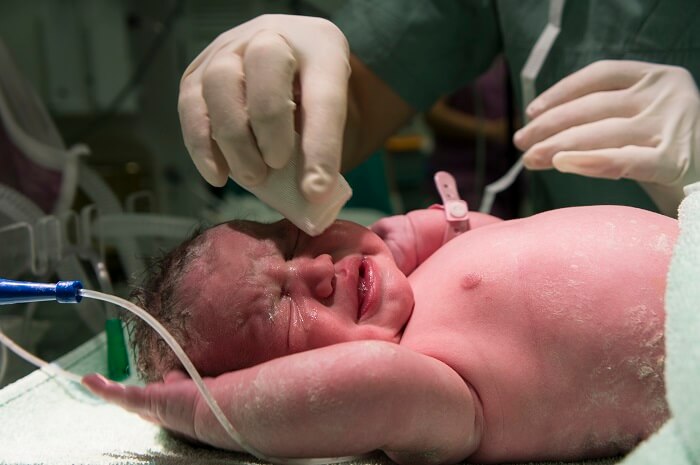Why Do Babies Cry Soon After They Are Delivered? What is the Scientific Reason Behind It?
Newborn babies entering the world often greet it with a distinctive sound - their cry. This universal phenomenon, filled with both curiosity and concern, has puzzled parents and intrigued scientists for centuries. In this article, we will delve into the scientific reasons behind why babies cry soon after they are delivered and explore the significance of this initial cry. Understanding this natural process can help parents navigate the early stages of parenthood with more confidence and empathy.
Introduction
Welcoming a newborn into the world is an extraordinary moment filled with joy, anticipation, and sometimes, a touch of anxiety. One of the most immediate and recognizable aspects of this experience is the baby's cry. It serves as a powerful indicator of a baby's vitality and marks the beginning of their journey outside the protective confines of the mother's womb.

The First Cry: A Sign of a Healthy Baby
The first cry of a newborn carries immense significance. It signals that the baby's lungs are functioning properly and that they have made a successful transition from a fluid-filled environment to breathing air. Additionally, the cry provides reassurance to parents and healthcare providers that the baby is alive and well.
Establishing Lung Function
During pregnancy, the developing baby's respiratory system undergoes essential growth and maturation. By the time of birth, the lungs are prepared to take on their vital role in sustaining life outside the womb. However, until the baby takes its first breath, the lungs are filled with fluid.
The first cry plays a crucial role in clearing this fluid and establishing lung function. When the baby cries, the pressure exerted on the chest helps expel the fluid from the air sacs. This process, known as lung aeration, allows the lungs to expand and fill with air for the first time.
As the fluid is cleared from the lungs, the baby's respiratory system undergoes a remarkable transition. The air sacs, known as alveoli, begin to inflate, and the tiny blood vessels surrounding them start to receive oxygen-rich blood. This oxygenation process is essential for the baby's survival and the proper functioning of their organs.
Furthermore, the first cry also stimulates the production of surfactant, a substance that coats the inside of the air sacs and prevents them from collapsing. Surfactant reduces the surface tension within the lungs, making it easier for the baby to breathe and maintain a stable respiratory pattern.
The establishment of lung function through the first cry is a vital milestone in a newborn's life. It marks the beginning of their independent breathing and sets the stage for a lifetime of respiratory health.
By encouraging and supporting the baby's first cry, healthcare professionals ensure the successful transition from the womb to the outside world. They carefully monitor the baby's breathing, assess their oxygen saturation levels, and provide any necessary interventions to promote optimal lung function.
It is important to note that while crying aids in establishing lung function, excessive crying or prolonged periods of crying can cause exhaustion and distress for the baby. As caregivers, it is crucial to provide comfort, reassurance, and a soothing environment to help calm the baby after their initial cry.

Initiating Breathing and Oxygenation
When a baby is delivered, there is a shift in their oxygen supply. While in the womb, the baby receives oxygen through the placenta. However, after birth, they need to breathe air to obtain oxygen. The act of crying helps initiate breathing by stimulating the respiratory centers in the baby's brain.
The cry triggers a reflexive response, prompting the baby to take their first breath. As they inhale and exhale, their lungs expand and contract, facilitating the exchange of gases and oxygenation of their blood. This transition from receiving oxygen through the placenta to breathing independently is a critical step in the adaptation to life outside the womb.
Clearing Fluid and Mucus
Another important reason babies cry soon after delivery is to clear the fluid and mucus from their airways. While in the womb, the baby's lungs are filled with amniotic fluid. During the birthing process, the pressure exerted on the baby's chest helps expel this fluid from the air sacs.
The cry aids in the clearance of residual fluid and mucus from the baby's nasal passages and throat. By crying, they can cough, sneeze, and produce sound vibrations that help dislodge any remaining fluid. This process ensures that their airways are clear and facilitates the smooth passage of air into their lungs.
Regulatory Systems and Survival Instincts
Crying is not only a physiological response but also a means of communication and self-preservation for newborns. When a baby cries, it activates the autonomic nervous system, which controls various bodily functions. This activation helps regulate their heart rate, blood pressure, and body temperature.
Furthermore, crying is a way for babies to communicate their needs and express discomfort or hunger. It serves as an instinctual mechanism that prompts caregivers to respond and provide the necessary care and attention. Crying acts as a powerful signal, ensuring the survival and well-being of the newborn.
Emotional and Social Factors
The cry of a newborn elicits a range of emotional responses from parents, family members, and healthcare providers. It often evokes a mix of excitement, concern, and a deep sense of responsibility. The cry serves as a bonding tool, forging a connection between the baby and their caregivers.
Moreover, crying establishes the foundation for communication between parents and their newborns. It prompts parents to engage with their babies, soothing and comforting them, and meeting their needs. Through this early interaction, a nurturing environment is created, fostering a sense of security and trust.
Crying as a Reflex and Form of Expression
Babies have different types of cries, each carrying its own unique meaning. While it may take time for parents to distinguish between them, understanding their baby's cries can greatly assist in meeting their specific needs. Crying is not limited to vocalizations but also encompasses non-verbal cues such as facial expressions, body movements, and gestures.
As parents become attuned to their baby's cries, they can interpret and respond to them effectively. This shared language between parent and child establishes a sense of understanding and reinforces the emotional bond. By acknowledging and addressing their baby's cries, parents can provide the care and support needed for their well-being.
Soothing Techniques for Newborns
When faced with a crying newborn, parents often seek ways to soothe and calm their baby. Gentle touch, swaddling, and rhythmic movements, such as rocking or carrying the baby, have shown to be effective in providing comfort. The closeness and warmth provided through these techniques mimic the sensations the baby experienced in the womb, promoting relaxation.
It's important for parents to understand that each baby is unique, and what works for one may not work for another. Experimenting with different soothing techniques can help identify what brings the most comfort to their baby. Some babies may find comfort in being held close to the caregiver's chest, while others may respond better to gentle rocking or rhythmic patting. It's a process of trial and error to discover what works best for their little one.
Common Causes of Crying in Newborns
Understanding the reasons behind a baby's cry can help parents identify and address their needs. While crying is a normal part of a baby's communication, certain common causes may trigger their cries. These can include hunger, sleepiness, discomfort, or overstimulation.
Babies have small stomachs and need to eat frequently. When they feel hungry, they will cry to communicate their need for nourishment. Similarly, when they are tired or need rest, they may cry to express their need for sleep. Discomfort caused by wet diapers, gas, or temperature changes can also lead to crying. Overstimulation from excessive noise, bright lights, or too much activity can overwhelm a baby and result in tears.
Recognizing the underlying cause of the crying can help parents address it appropriately. By attending to their baby's needs promptly, parents can provide comfort and create a nurturing environment.
Seeking Medical Attention
While crying is a normal part of a baby's behavior, there may be instances where it becomes excessive or unusual. If a baby's cry is accompanied by other concerning symptoms such as fever, lethargy, difficulty breathing, or changes in feeding patterns, it is important for parents to seek medical attention.
These symptoms could be indications of underlying health issues that require evaluation and treatment. It is always better to err on the side of caution and consult a healthcare professional if parents have any concerns about their baby's well-being.
Parental Support and Understanding
Dealing with a crying baby can be challenging and overwhelming for parents, especially for new parents who may be experiencing parenthood for the first time. It is essential to approach these moments with empathy, patience, and a willingness to learn.
Babies cry as a means of communication, and by responding to their cries with love and care, parents can foster a sense of security and trust in their baby. Understanding that crying is a normal part of their development can alleviate parental anxiety and help create a more positive caregiving experience.
Building a support system and seeking guidance from healthcare professionals, family, or friends who have experienced parenthood can provide reassurance and practical advice. Remember, parenting is a journey, and with time and practice, parents become more attuned to their baby's needs.
Conclusion
The cry of a newborn baby holds profound significance, serving as a sign of their healthy transition into the world. It is a natural process through which babies establish their lung function, initiate breathing, clear fluid and mucus from their airways, and communicate their needs.
By understanding the scientific reasons behind why babies cry soon after delivery, parents can approach this process with greater knowledge and confidence. Creating a nurturing environment, responding to their baby's cries, and seeking medical attention when necessary contribute to the well-being and development of the newborn.
Remember, each baby is unique, and the journey of parenting is a learning experience. Embrace the opportunity to bond with your baby, and with time, you will become more attuned to their needs and develop a deeper understanding of their cries.
FAQs (Frequently Asked Questions)
Why do newborn babies cry so much?
Newborn babies cry to communicate their needs, such as hunger, discomfort, or fatigue. It is their way of expressing themselves.
How long do newborns typically cry each day?
On average, newborns can cry for around two to three hours per day. However, this can vary from baby to baby.
Can crying harm a newborn's vocal cords?
No, crying does not harm a newborn's vocal cords. Crying is a natural behavior and does not cause any damage to their vocal cords.
Are there any techniques to soothe a crying baby?
Yes, there are various soothing techniques that can help calm a crying baby. These include gentle rocking, swaddling, soft singing or humming, and offering a pacifier.
When should I seek medical attention for my crying newborn?
If your newborn's cry is accompanied by other concerning symptoms, such as fever, lethargy, difficulty breathing, or changes in feeding patterns, it is advisable to seek medical attention to rule out any underlying health issues.
By Dr. Denial B.
You may Read- 200 Life Hacks
Do You Know How Boost Your Personal Income - Read

